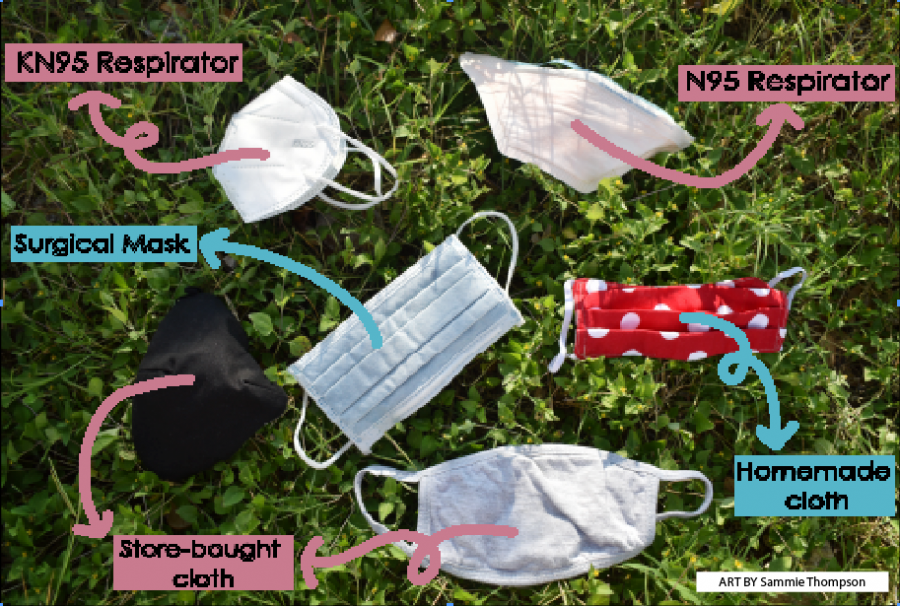Mask up: review of the most effective mask types
November 12, 2020
At this stage in the pandemic, the evidence is clear: face masks are effective and necessary tools in fighting against COVID-19. But with so many options for face masks available, the question arises: what type of mask is best?
There are four main categories of face coverings that are available to the general public: surgical masks, cloth masks, neck gaiters, and professional-grade respirators.
Surgical masks are disposable, loose-fitting face coverings that are often made of paper and plastics. Cloth masks are made out of fabric and are typically tighter-fitting than surgical masks. Neck gaiters are thin, tube-shaped coverings that go over the neck and face and are typically made of fabrics and other materials, such as polyester and spandex. Lastly, professional-grade respirators, such as N95 or KN95 masks, are highly effective medical masks that form a tight seal against the face.
Out of these four categories, my favorite type of masks to wear are cloth masks. I like wearing cloth masks because they are comfortable, reusable, and tight enough that I feel myself and the people around me are less at risk for spreading or receiving COVID-19. Cloth masks can also be a form of expression. With the option to buy a cloth mask from a store or to make one yourself using instructions from the Centers for Disease Control and Prevention (CDC), the choices for mask color and design are nearly endless.
Both the CDC and the World Health Organization (WHO) advise the general public to use non-medical, fabric masks. This is because medical masks, such as disposable surgical masks and N95 respirators, are critical supplies for healthcare workers. The CDC recommends that these medical masks should be conserved for people in these occupations who need them the most, unless it is the only type of face covering that is available.
Additionally, not all respirator-type masks are equal. Two popular respirators, N95 and KN95 masks, differ in where they are certified. They are both said to filter out 95 percent of aerosols, but a recent report by ECRI has found that this percentage might actually be lower for KN95 masks. Despite this finding, KN95 masks are still considered to be useful in low-risk settings.
Within these four main categories, there are many other things that determine the effectiveness of face coverings, especially for cloth masks.
Because cloth masks can be homemade or bought from many different stores, their level of effectiveness varies more than medical masks and respirators, which are commonly tested by their producers.
The CDC recommends choosing or making a cloth mask that has two or more layers of breathable fabric. It is also recommended that the fabric can be washed after each usage. Another thing that can affect a mask’s effectiveness is how tight it is to the wearer’s face.
Many masks have metal nose strips in them that can conform to the mask wearer’s face, which I really like because they feel secure but are still very comfortable and easy to maneuver.
Lastly, cloth and medical masks can have exhalation valves on them, which are one-way valves that open when the mask-wearer exhales, making it easier to breathe. The CDC warns against masks with exhalation valves because while they do protect the mask-wearer, they do not provide any protection to the people around them.
Despite the CDC and WHO’s multiple attempts at providing clear mask guidance, misinformation and confusion surrounding face masks has run rampant.
A study published in August from Duke University only poured fuel on the fire. The study was perceived by many media outlets to conclude that wearing neck gaiters was worse than wearing no mask at all because the gaiters could break large germ-infested particles into smaller ones that could hang in the air.
After the publication of this study and the debate that ensued, the authors of the study pushed back against this claim, stating that it was mostly “speculation” due to a lack of conclusive evidence.
Personally, I wouldn’t choose to wear a neck gaiter. There are so many other options that have definite evidence that they protect both the mask wearer and the people they are around.
Now that we’ve gone over the types of face coverings to buy and the types to avoid, let’s look at the regulations Austin Independent School District (AISD) has in place for mask-wearing during in-person learning.
Not surprisingly, the regulations are based on CDC guidance. AISD is requiring all people two years and older to wear a face mask that completely covers the nose and mouth and snugly fits onto the face while they are on campus.
Students are encouraged to bring their own reusable cloth mask that can be washed every day, however, masks will be provided to everybody who arrives at school without one to use for that day. Bandannas/gaiters and masks with exhalation valves are not allowed.
I believe that the use of masks and other face coverings are absolutely necessary in order to stay safe during this pandemic, as long as they are used properly. Not only is it important to choose a mask that is effective, that mask also has to be used consistently and responsibly. I would recommend investing in several cloth face masks that can be worn daily and washed in between uses.
According to the staff at Mayo Clinic, wearing face masks and using preventive measures to reduce infection, such as social distancing and frequent hand washing, significantly helps slow the spread of COVID-19. Let’s listen to the scientists on this one.










